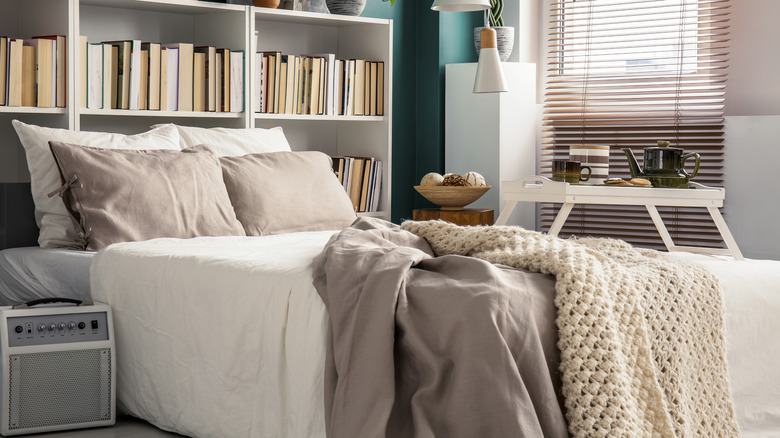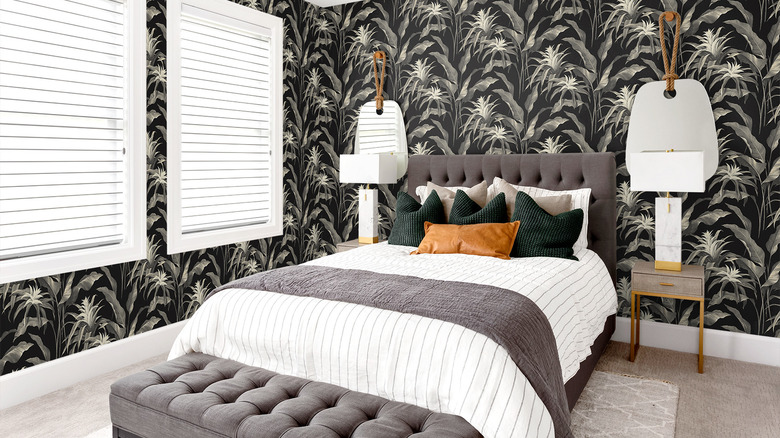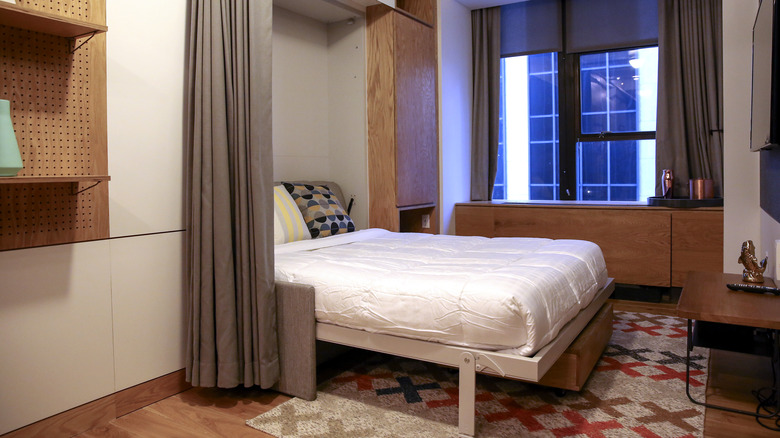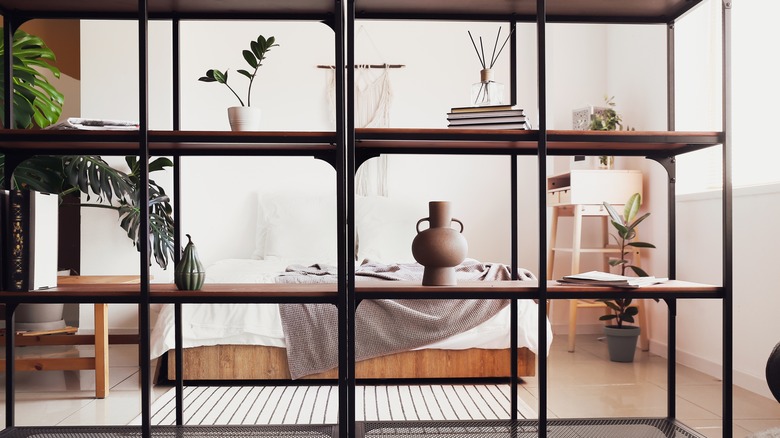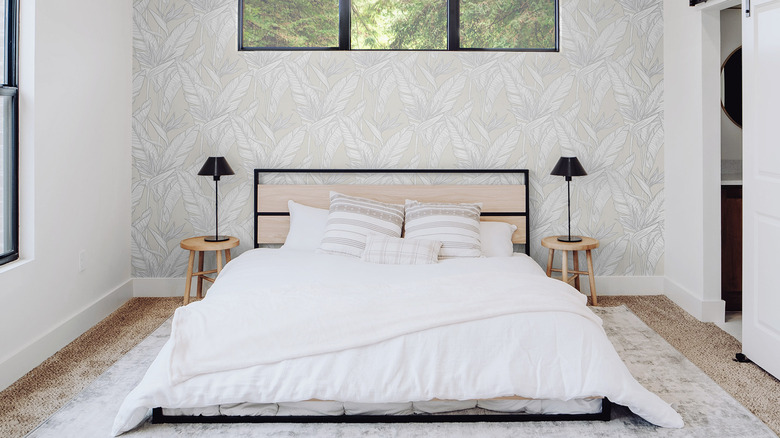A Design Expert Explains The Best Furniture Layout For A Small Bedroom
If you're lucky enough to have a super-sized bedroom, you likely have a ton of flexibility when it comes to your furniture layout and design choices. Many individuals, however, are trying to make a relatively small bedroom feel chic, cozy, and functional — which can pose a challenge. KR Strategies highlights several mistakes people tend to make when designing a small bedroom, from cramming in too many decorations and furniture pieces to forgetting about adequate storage or using dark colors in the wrong areas. "Small bedrooms require a bit more creativity in terms of design and layout and, of course, less is more," explains interior designer Stacy Garcia, founder of Stacy Garcia Inc.
According to Garcia, the first step is to pare down the amount of furniture you incorporate in the space. "Keep your modest room uncluttered for a more open feel — think modern minimalist," she recommends. Once you know exactly which pieces you love and want to include in your design, there are a few best practices for how exactly you should lay everything out. In an exclusive interview with House Digest, this expert designer shares more of her top tips to ensure you have the small but stunning space you've always dreamed of.
Collect your measurements
Measuring may be a step you're tempted to skip, especially if you're not adding too many new pieces of furniture. Or, perhaps you get lazy and only measure a few key areas. After all, if your bed and nightstands fit in their current layout, surely they'll fit when you revamp the space and place them in a new spot, right? According to Stacy Garcia, both failing to measure and not measuring thoroughly enough are huge mistakes. "The key to getting started is to make sure you have all the room's measurements," she advises. "Each one will be important, including the placement of the windows and their height, ceiling height, and door measurements."
While you have to spend a bit more time upfront getting all these measurements, trust us, you'll save a ton of time in the long run. If there are certain measurements that are incorrect or that you just don't have, you'll end up moving things around multiple times, Tetris-style, as you attempt to create the ideal layout. You may even have to take a few trips back to the store when you realize that your faulty measuring means your curtains don't fall to where you want them to, or that the gorgeous new mirror won't actually fit where you intended to hang it. "Don't guess — measure and create a diagram to help plan out your design," says Garcia.
Position your bed
In the majority of cases, your bed will be the biggest piece of furniture in your small bedroom, and likely the default focal point as well. The visual impact of the bed means it's crucial to find the best spot in the layout for this key piece of furniture, which may not be totally intuitive. As Stacy Garcia outlines, the temptation to push the bed into a corner where two walls meet in order to maximize usable square footage should be resisted. "Instead, place the bed in the center of the main wall and add a side table or nightstand to one side," she suggests. If you're very low on space, you could even consider skipping the nightstand or side table entirely and adding something like an overhead shelf or hanging light fixture in the vicinity of the bed instead. Similarly, a handy bedside storage system that hooks onto the side of the bed will hold many of your essentials without taking up any floor space.
Garcia's recommended bed positioning prioritizes the flow and functionality of the space. "This [placement] will also leave room to change the sheets with ease and allow for the addition of a plant or other décor piece on the other side," she explains.
Use creative bed options
As previously mentioned, the bed is likely the largest and most important piece of furniture in the room, so it should be pulling double duty when possible. If you're buying a new bed, don't focus only on the aesthetics — try to see what else your bed can bring to the space besides a place to sleep. "Choosing a bed with drawers and storage underneath will maximize the space," notes Stacy Garcia. If you're not planning on purchasing a bed, look into storage containers or bins that can slide underneath your existing bed for the same purpose. (And if your bed is quite low to the ground, simply investing in some bed risers should solve that problem). As a bonus, since it's tucked away out of sight, under-the-bed storage won't make your space feel too full or cluttered, allowing you to keep that modern minimalist vibe that Garcia favors in small bedrooms.
If your bedroom is extremely tight, or if you want the flexibility to use it for other purposes during the hours when you're not sleeping, consider reevaluating whether you need a traditional bed at all. "You can create a more flexible space by installing a Murphy bed," recommends Garcia. "These have come a long way from their early designs. They offer plenty of storage and beautiful framing, ensuring that the room can double as an office or sitting room."
Utilize height
There's a reason that Stacy Garcia advocates for taking every possible measurement in your small bedroom before planning the layout, including all the vertical measurements — it's a mistake to only think horizontally in any compact space. "When planning for a small bedroom, be sure to use the height of the room for storage. Consider bookshelves that go to the ceiling or shelving on either side of the bed that can double as side tables as well," the designer suggests. Thinking vertically will not only give you more storage options without taking up more square footage of floor space, it'll also draw the eye upwards, making the room feel bigger. If shelving isn't possible in certain areas, you could also think outside the box with hooks, bars, pegboards, or other wall-mounted storage solutions that take up very little space.
In addition to selecting pieces that stretch vertically, pay attention to the overall structure of those pieces. "Furniture that has a more open structure... will make the room feel larger, allowing for space and light to flow," Garcia recommends. Just as you don't want to push your bed lengthwise against a wall to maximize space, you don't necessarily want to push your other furniture pieces against the perimeter walls either. An open shelving unit that you can see through, for example, can serve as a room divider that creates distinct zones in your bedroom without blocking out the light.
Place rugs strategically
Area rugs can have a huge visual impact on a space, and add a ton of coziness and texture. Don't overlook this design element when planning your small bedroom layout — just be mindful of proportions. "Placing an area rug under the bed but allowing 3 feet or more beyond will help the room feel larger," outlines Stacy Garcia. "The dimensions of the rug will depend on the size of the room and the bed." If you have nightstands or additional furniture directly surrounding the bed, such as a bench at the foot of it, you'll ideally want all the legs of those pieces to sit on top of the rug as well. If that's not possible, make sure your nightstand legs aren't half-on and half-off, as that will jeopardize their stability.
Bold colors or patterns on an area rug might overwhelm a small space, whereas according to Garcia, "a neutral color area rug will act as a base [upon] which you can build." If you're concerned a neutral rug will be too boring, look for something with an interesting texture and visual details such as fringe, or a more subtle pattern that uses similar tones. "If you have wood floors, be sure to show them off by leaving a border showing," Garcia adds. And, in that case, you should also make sure you have a rug pad underneath so the rug stays put and feels comfortable under your feet.
